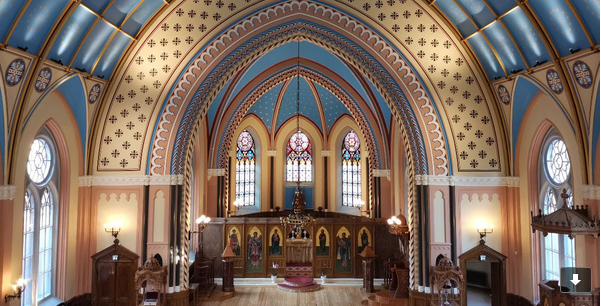The speech of His Eminence Metropolitan Cleopas of Sweden during the “8th Summer School on Human Rights”, a webinar organized by The Conference of European Churches & the Protestant Church in Germany, July 20, 2021.
Dear Organizers & Participants of the “8th Summer School on Human Rights”,
Allow me to begin by taking the opportunity to thank the organizers of this year’s conference for their kind invitation to participate in this event, as well as you, the audience, for joining us for this webinar. I am humbled and pleased to spend the next few minutes sharing some thoughts with you about holy places of worship from an Orthodox Christian perspective. Naturally, the insights I will be sharing with you are in many ways not exclusive to Orthodox Christian churches alone. In many cases, they represent a continuation of norms, customs, and traditions inherited from the classical era as well as the Judaic rite, and over time, were cultivated and developed in line with Orthodox Christian theology.
My first thoughts when drafting my outline for today’s discussion go back to a time before the official establishment of the Church on the day of Pentecost. The two scenes that initially came to my mind were, first, our Lord’s denouncing of the Pharisees in Chapter 23 of the Gospel of Matthew. There, at the end of his famous “Woes” warning of their hypocrisy, Christ speaks of how the prophets were murdered, telling the Scribes and Pharisees “that on you may come all the righteous blood shed on the earth, from the blood of righteous Abel to the blood of Zechariah, son of Berechiah, whom you murdered between the temple and the altar.”
Secondly, my mind turned to the infamous example of Herostratus, a 4th-century BC arsonist, who sought notoriety by destroying the second Temple of Artemis in Ephesus. His acts prompted the creation of a law forbidding anyone to mention his name, orally or in writing, in order to ensure that his example would not live on and be emulated by others seeking ill fame. The law was ultimately ineffective of course, as evidenced by mentions of his existence in modern works and parlance. Herostratus may have remained present in history, however, he has become an eponym for someone who commits a criminal act in order to become famous.
And so, faithful to the Orthodox Christian theological tradition, we begin today apophatically, which is to say, we begin by outlining what the Church is not. We hear Christ Himself make a particular point about the heinousness of committing murder inside the temple – something that was considered barbaric and evil even in antiquity. In ancient Greece, temples were considered places of asylum, and it was not permitted to murder or commit acts of violence inside a temple. Those who did not comply were punished and ostracized, as disrespect of the sanctity of the worship space was considered sacrilegious.
Likewise, the paradigm of Herostratus has been met with perennial historical contempt because of the anti-social and self-centered madness of one individual targeting the sanctity of a collective worship space. This atrocious act was compounded by the fact that the perpetrator destroyed a site of exceptional beauty, which served as a cultural monument in additional to its religious functionality.
Hence, speaking apophatically, we can begin to comprehend holy places of worship as sites that symbolize humanity’s attempt to transcend its individuality, its most base traits, and its most animalistic instincts and strive toward attaining its divinely ordained destiny of reaching the likeness of God, in whose image we were created.
As we transition to a more positivist approach of understanding worship spaces, I would now like to direct your attention to the role of the worship space within the Christian community. Reading through Holy Scripture, we can find instances where the description and role of places of worship is very purposeful and deliberate. The detail and description with which the Holy Temple and the Holy of Holies is described in the Old Testament, but also in the New Testament in St. Paul’s Letter to the Hebrews, is very precise, and the Orthodox Church retained these guidelines to a very large degree.
However, at the same time, Christ Himself adopts positions regarding worship spaces that are seemingly antithetical. On the one hand, we are instructed by the Lord to strive for brevity in our prayers and avoid long, drawn-out supplications solely for the purpose of putting on a display. We also hear the Lord, in his teaching during His interaction with the Samaritan woman, tell her, “Woman, believe Me, the hour is coming when you will neither on this mountain, nor in Jerusalem, worship the Father. You worship what you do not know; we know what we worship, for salvation is of the Jews. But the hour is coming, and now is, when the true worshipers will worship the Father in spirit and truth; for the Father is seeking such to worship
Him. God is Spirit, and those who worship Him must worship in spirit and truth.” (John 4: 21-24).Meanwhile, we also witness the scene where Christ casts out the merchants and money exchangers from the temple, telling them that “it is written, My house shall be called the house of prayer, but you have made it a den of thieves.” (Matthew 21:13). Elsewhere, in his condemnation of the Pharisees, the Lord criticizes them for their misguided teaching that the gold of the sanctuary and the gift of the altar are greater than that which sanctifies them; namely, the sanctuary and the altar themselves. “Woe to you, blind guides, who say, ‘Whoever swears by the sanctuary is bound by nothing, but whoever swears by the gold of the sanctuary is bound by the oath.’ You blind fools! For which is greater, the gold or the sanctuary that has made the gold sacred? And you say, ‘Whoever swears by the altar is bound by nothing, but whoever swears by the gift that is on the altar is bound by the oath.’ How blind you are! For which is greater, the gift or the altar that makes the gift sacred? So whoever swears by the altar, swears by it and by everything on it; and whoever swears by the sanctuary, swears by it and by the one who dwells in it; and whoever swears by heaven, swears by the throne of God and by the one who is seated upon it.”
Therefore, we can see Christ attest to both the omnipresence of God and the superfluousness of legalistic rites, while at the same time, He vehemently defends the sanctity of the temple, removing all materialistic influences from within and ensuring that it is dedicated to its original purpose – prayer and communication with God.
In Orthodox theology, the church is often equated with a hospital and those inside the sacred space are viewed as patients who are receiving a specific therapy. The Church has many medicines and remedies; chiefly the Holy Sacraments. Our sacred places of worship house the lifegiving Sacrament of Holy Communion and serve as the stage for the celebration of the divine drama and bloodless sacrifice that commemorates Christ’s sacrifice on the Cross during every Divine Liturgy. Equally, our sacred spaces are the treasuries of the Holy Myrrh (from the Sacrament of Chrismation). They frequently – although not exclusively – serve as the chief setting for the commemoration of other sacraments like Baptism, Confession, and Matrimony. In this sense, they are the areas where the primary mode of spiritual healing, through the gifts of Divine Grace, are distributed to the congregants by the celebrants.
But the concept of the holy worship place as a spiritual hospital extends even further. The traditional Orthodox Church aims to engage all of the senses of the faithful in this therapeutic alliance being forged. The incense engages our olfactory senses, the sacred iconography engages our eyesight and sense of touch when we venerate the icons, the chanting and sermons minister to our ears. Inside these sacred places of healing, the Church ministers to the entirety of the person, to help the faithful in fact become “whole,” which is another way to interpret the Greek word “σώος,” typically translated as “saved.”
These sacred spaces also provide a living testament to the history and “phronema” or belief of the Orthodox faithful. For example, it is not possible to truly appreciate the iconography of an Orthodox Christian house of worship without understanding the triumph of icons during the period of iconoclasm. The theology of the icon, which can be summarized as the sanctification of the created world through the circumscription of the divine in the sacred person of Jesus Christ, is authentically witnessed inside every Orthodox church. Of course, it goes without saying that this living testament to history through Byzantine art and music also represents a significant piece of tangible and intangible cultural heritage.
Therefore, although Christ’s ministry on earth led to the worshipping of God in spirit and truth, without the need for constant sacrificial offerings and purification, it also reinforced the role of the Christian faith’s holy sites as treasuries that store the Grace of God, thus sanctifying both the area housing it and those who draw near in faith.
Finally, it is worth mentioning that the exterior design of these sacred worship sites also has a special significance signaling humanity’s respect for creation and “synergy with God” (1 Cor. 3:9). Traditional Orthodox churches attempt to harmoniously blend with their environment. Their domes and vaults mirror the shape of the hills in the countryside, while the whitewashed island churches mirror the foam of the waves. The Greek Nobel laureate Odysseas Elytis famously writes about “’churches in the shape of the heavens” in his poetic masterpiece “Axion Esti.” Traditionally, churches were aimed to be designed in a manner that projects balance and harmony with the surrounding environment, thus demonstrating an ecological consciousness that is so eloquently exhibited and communicated by His All-Holiness Ecumenical Patriarch Bartholomew, spiritual leader to the world’s Orthodox Christians.
Inspired by the “green patriarch’s,” as Patriarch Bartholomew is sometimes fondly referred to internationally, love for the environment and calls for international sensitization to the global climate change crisis confronting us, the Holy Metropolis of Sweden, which I have the honor of shepherding for the past seven years, has embarked on a campaign to renovate and restore its own sacred spaces.
By the Grace of God, despite the unprecedented challenges of the global pandemic and the financial challenges facing our missionary Metropolis, I am pleased to say that we have successfully completed the full restoration of the St. George Cathedral in Stockholm and of the Metropolitan Church of the Annunciation of the Virgin Mary in Oslo. In addition, we were blessed to open the Museum of Hellenic Christian Heritage, which was inaugurated by the Ecumenical Patriarch himself, and housed inside the St. George Cathedral.
All these efforts, inspired by the ministry of our Patriarch and the teachings of Orthodox theology, are aimed at promoting a dialogue with both Orthodox faithful and heterodox visitors to our place of worship who are interested in learning more about the faith, as well as the people who embody it. While serving to perpetuate history and culture, I humbly believe that it also serves humanity’s constant search for sanctity on the path from individual to person, from the image of God to the likeness of God.
Thank you.






































